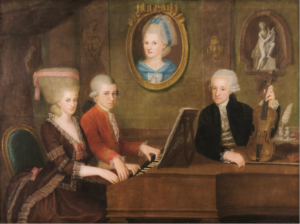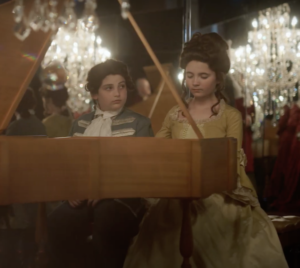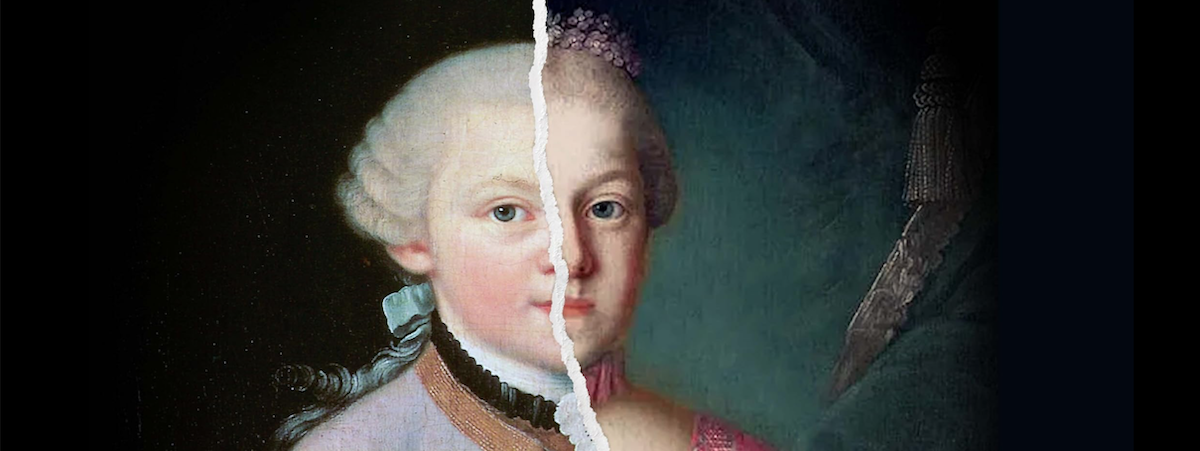The San Luis Obispo International Film Festival has given SLO Review the opportunity to preview some of the narrative and documentary films on the festival’s April 24-29, 2025 program schedule. Follow the links to purchase tickets to see these notable films for yourself.
A 250-Year-Old Musical Mystery
I once found, in my family tree, my ninth great-grandmother, now vanished beneath pavement in what was once a London churchyard. She died three years before the Armada. I imagined her as a girl:
At puberty, Lady Elizabeth [Gelsthorpe Gregory] would’ve been enshrouded in clothing almost as barbaric as the not-yet-invented whalebone corset: linen petticoat surmounted by a stiffened bodice, or kirtle, that mashed the breasts and stifled breathing and then, over that, the gown for noblewomen, made of dense and elaborate fabric (velvet, or even cloth of gold for prospective noble marriages); the gown would’ve been nearly as heavy as the chains sported by Marley’s ghost. English or French hoods—the latter, Anne Boleyn’s innovation—covered most of a woman’s head. Lady Elizabeth, like most Tudor women, grew up in a cocoon.
Two hundred years later, in the Enlightenment, despite the brilliance of women like Mary Wollstonecraft, Olympe de Gouges and Abigail Adams, the mathematician Émilie du Châtelet and the astronomer Caroline Herschel, women remained cocooned.
In the one-woman play The Other Mozart, playwright/actress Sylvia Milo appears as Wolfgang Amadeus Mozart’s older sister, Maria Anna (1751-1829). Surrounded by a sea of fabric—petticoats and a vast court dress—she appears in the center, inside a wooden corset and pannier, the latter intended to support the fabric that extended the width of a woman’s hips.
She, too, is cocooned. Because of that, Maria Anna Mozart is hard for historians to find.
The documentary film Mozart’s Sister makes that attempt but fails to find a “smoking gun,” a composition that reveals, definitively, that it was written by Mozart’s sister.
What director and screenwriter Madeleine Hetherton-Miau does reveal is that Maria Anna hasn’t completely vanished.
Maria Anna is believed to have been a composer as well as a masterful keyboardist.”
She grew up loving and admiring Wolfgang, younger by four years, and the feeling was reciprocated. Their father, Leopold, gifted her with a musical notebook from which she practiced at the harpsichord, and both her recollections of their childhood plus the later four-hand piano pieces composed by her brother suggest that they played together. They suggest, from the margin notes, that she, as well as their father, might’ve taught the little boy.

Leopold took the two, aged 10 and six, on a tour of Central Europe that culminated with a performance at the Hapsburg Court in Vienna. Two years later, Wolfgang wrote Symphony No. 1 in E Flat Major.
The symphony is made up of three movements, the first and third exuberant and playful, the middle part slower and elegant. Conductor Paul Dyer is convinced that this part of Mozart’s first symphony belongs to his sister: “The wisdom of an older child really comes through” in the middle passage, Dyer insists.
Wolfgang, of course, would come through, renowned as the composer of more than 600 pieces of music in his 36 years. Maria Anna wouldn’t.
 The change came when she turned 15. By then, their father, always impecunious, had turned more and more toward teaching his son, hoping someday that he would find a steady living as kapellmeister for an archbishop or prince. There was no future in Maria Anna.
The change came when she turned 15. By then, their father, always impecunious, had turned more and more toward teaching his son, hoping someday that he would find a steady living as kapellmeister for an archbishop or prince. There was no future in Maria Anna.
This was, of course, the product of the misogyny that thrived even in the Enlightenment. Rousseau, for example, argued that “women, in general, are not attracted to art at all, nor knowledge, and not at all to genius.”
In conservatively Catholic Austria, girls were not taught to be musicians (the cello being a particularly horrifying instrument), and women artists performing professionally were equated with prostitutes. Composition, too, was out of the question.
But Maria Anna is believed to have been a composer as well as a masterful keyboardist. In its attempt to establish this, the film uses four conductors, musicologists and even a forensics handwriting expert. One tantalizing piece of solid evidence comes in a letter from her brother, who praises a minuet, now lost, that she’d sent him.
An estrangement from Wolfgang emerged about the time of the letter; he’d urged her to come to Vienna but then married unexpectedly. His sporadic employment as a performer and conductor meant that supporting a sister was impossible.
Too much of Maria Anna remains to be learned. What ‘Mozart’s Sister’ does is to validate the search for her.”
So Maria Anna did what women had to do: At 34 she married an older man and moved to a lakeside town whose sole culture consisted of her devotion, three hours a day, to playing at a clavichord whose tuning became impossible in the damp air.
There was a kind of comeback. As a widow, independently wealthy, she returned to Salzburg and re-established herself as the piano virtuoso that she’d been since her childhood. She moved into an apartment from whose windows she could see the distinctive yellow apartment building where she and her brother had grown up.
In another part of the square, facing the Mozart home today, there is a bakery whose window is graced with impossible pastries, many filled with cream or jam. They are airy and crispy, and crumbs fall down your chin as you reach the soft center.
This film is like that: beautifully photographed, beautifully scored, intelligently written. But it disappears as quickly as a Salzburg pastry. Too much of Maria Anna remains to be learned. What Mozart’s Sister does is to validate the search for her.
Editor’s Note: Screenings of Mozart’s Sister (Australia, run time 97 minutes, rated G, in English, US premiere) at the SLO International Film Festival are sponsored by Festival Mozaic.
